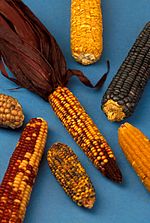- Maya cuisine
-
Ancient Maya cuisine was varied and extensive. Many different types of resources were consumed, including maritime, flora, and faunal material, and food was obtained or produced through a host of strategies, such as hunting, foraging, and large-scale agricultural production. Plant domestication focused on several core foods, the most important of which was maize.
To fight these deficiencies, the Maya adopted a number of adaptive techniques that, if necessary, allowed for the clear-cutting of land and re-infused the soil with nutrients. Primary among these was slash and burn, or swidden, agriculture, a technique that cleared and temporarily fertilized the area to be cultivated. For example, the introduction of ash into the soil raised the soil’s pH, which in turn raised the content of a variety of nutrients, especially phosphorus, for a short period of time, which may be around two years long. However, the soil will not be suitable for planting for as many as ten years. This technique, common throughout the Maya area, is still practiced today in the Maya region. Complementing swidden techniques was crop rotation and milpa farming, which were employed to maintain soil viability and increase the variability of cultivated crops.
Contents
Staples
 Varieties of maize
Varieties of maize
Maya diet focused on four primary domesticated crops (staple foods): maize, squash, beans (typically tepary beans or common beans) and chili peppers. The first three cultivates are commonly referred to in North America as the "Three Sisters" and, when incorporated together in a diet, complement one another in providing necessary nutrients. Paramount among the three, maize (corn) was the central component to the diet of the ancient Maya, and figured prominently in Maya mythology and ideology. Maize was used and eaten in a variety of ways, but was always nixtamalized. Nixtamalization (a term that derives from the Nahuatl word for the process), is a procedure in which maize is soaked and cooked in an alkaline solution. This releases niacin, a necessary B vitamin (vitamin B3) that prevents pellagra and reduces incidents of protein deficiency.
Once nixtamalized, maize was typically ground up on a metate and prepared in a number of ways. Tortillas, cooked on a comal and used to wrap other foods (meat, beans, etc.), were common and are perhaps the best-known pre-Columbian Mesoamerican food. Tamales consist of corn dough, often containing a filling, that are wrapped in a corn husk and steam-cooked. Both atole and pozole were liquid based gruel-like dishes that were made by mixing ground maize (hominy) with water, with atole being denser and used as a drinking source and pozole having complete big grains of maize incorporated into a turkey broth. Though these dishes could be consumed plain, other ingredients were added to diversify flavor, including, for example, chili peppers, cacao, wild onions, and salt.
An alternative view is that manioc was the easily-grown staple crop of the Maya and that maize was revered because it was prestigious and harder to grow.[1] This proposal was based on the inability of maize to meet the nutritional needs of densely populated Maya areas. Manioc can meet those needs. Because tuberous manioc rarely survives in the archaeological record, evidence for this view has been lacking, although recent finds in volcanic ash at the southern Maya site of Joya de Cerén in El Salvador may be such evidence.[2]
Several different varieties of beans were grown, including pinto, red, and black beans. Other cultivated crops, including fruits, contributed to the overall diet of the ancient Maya, including tomato, chili peppers, avocado, breadnut, guava, guanabana, mamey, papaya, pineapple, pumpkin, sweet potato, and xanthosoma. Chaya was cultivated for its green leaves. Chayote was cultivated for its fruit, and its tender green shoots were used as a vegetable. Various herbs were grown and used, including vanilla, epazote, achiote (and the annatto seed), white cinnamon, hoja santa, avocado leaf, garlic vine, “Mexican” oregano, "Mexican" anise, and allspice
Meats
Hunting supplied the Maya with their main source of meat, though several animals, such as dog and turkey, may have been domesticated. Animals hunted for meat, as well as for other purposes, include deer, manatee, armadillo, tapir, peccary, monkey, other types of fowl, turtle, and iguana. The Maya diet was also supplemented by the exploitation, at least in coastal areas, of maritime resources, including fish, lobster, shrimp, conch, and other shellfish.
Other
The Mayans are believed to be the first people to have discovered and cultivated the cacao plant for food. They ground the cacao beans up and mixed them with chili peppers, cornmeal, and honey to create a drink called xocolatl (which is Nahuatl). Just the rich and noble could drink this. They also used cacao beans as a ceremonial sacrifice to their gods.
See also
- Agriculture in Mesoamerica
- Domesticated plants of Mesoamerica
- Native American cuisine
- Maya maize god
Notes
References
- Coe, Sophie D. (1994) America's first cuisines ISBN 0-292-71159-X
History of cuisine Ancient Egyptian cuisine · Ancient Greek cuisine · Ancient Israelite cuisine · Ancient Roman cuisine · Cuisine of the Thirteen Colonies · Maya cuisine · Andean cuisine · Aztec cuisine · Byzantine cuisine · Medieval cuisine · Ottoman cuisine · Early modern European cuisine · History of Chinese cuisine · History of French cuisine · History of Hawaiian cuisine · History of South Asian cuisine · History of Italian cuisine · History of Japanese cuisine · History of Jewish cuisine · History of Polish cuisine · History of Scottish cuisineCategories:- Maya society
- Mesoamerican cuisine
- Native American cuisine
- Indigenous cuisine of the Americas
- Mesoamerican diet and subsistence
Wikimedia Foundation. 2010.
